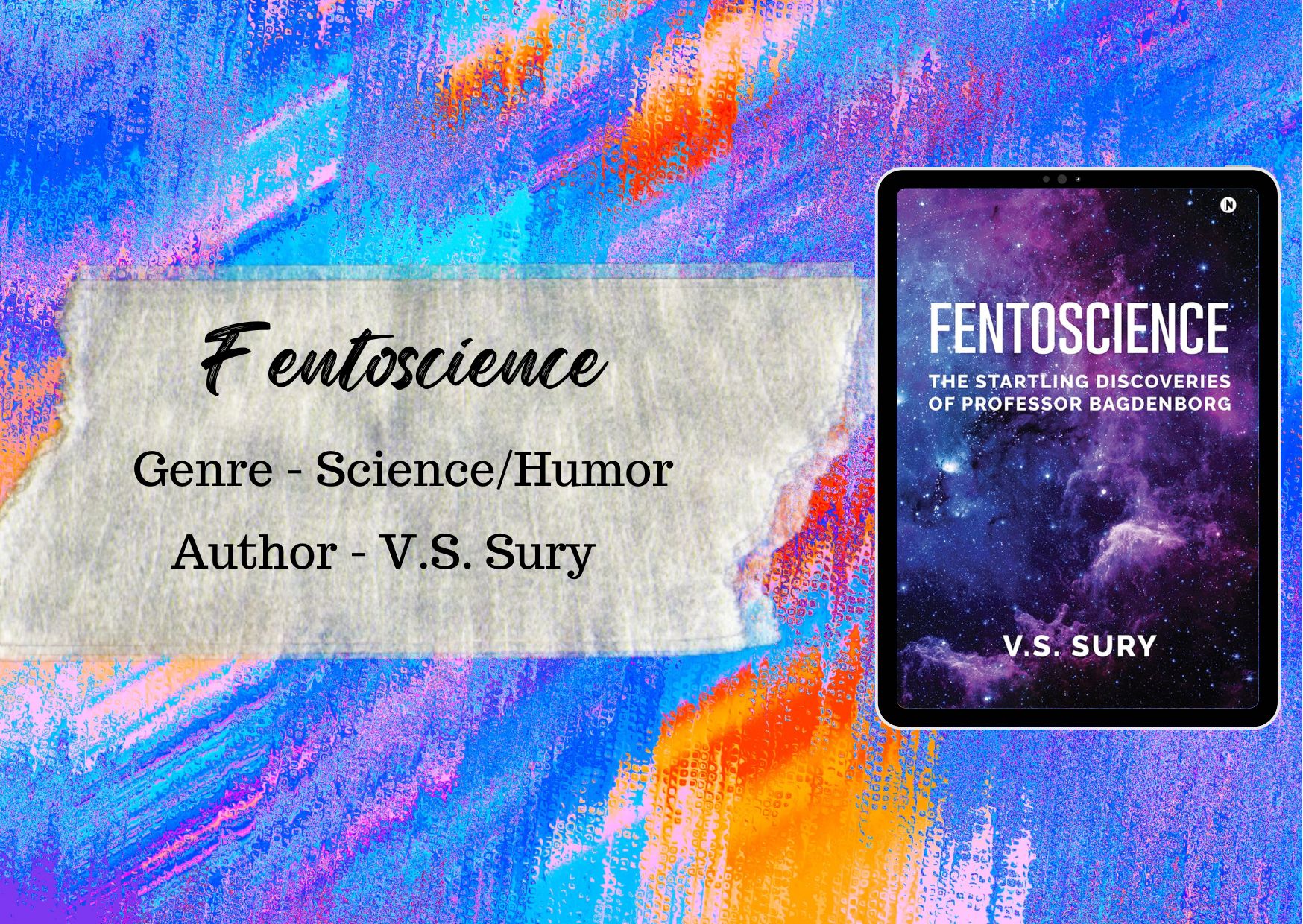
Book Review – Fentoscience – The Startling Discoveries of Professor Bagdenborg
Fentoscience: Soaring, as it were, through the world of imagination
V.S. Sury’s “Fentoscience: The Startling Discoveries of Professor Bagdenborg” offers an amusing view at the theories of this academic mythical figure that are filled with comic contradictions in an overloaded Superman’s capacious mind. The book introduces us to Professor Bagdenborg, a narcissist whose personality is conceived of by a hundred different names (each one is a reflection of brilliance of course) and a ground-breaking process of scientific exploration. Enough with those boring drills packed with endless equations and the tedious repetition of experiments! Professor Bagdenborg instead opts for thinking outside the box and suggests that along with the power of imagination, which is barely harnessed, can change it all.
Professor Bagdenborg gives a talk that follows him providing statements and theories in what is more or less his hippy philosophical view electively but when the moment of thinking comes the witty voice leaves him to the conscious thoughtlessness of the one seeking a clear minimalistic interpretation of physics. The book discusses the atom’s structure (Professor Bagdenborg sees the atom as a fried egg) and the Earth’s gravity (this is caused by an ever-present, reticent Earth). Sury, in a comedic and often scientific manner, alas, twines destined poetry made from humour and information. He brings into play his scientific terminology in the content of the story, but nonsense Professor Bagdenborg’s tale instead, setting the stage for a more conscientious use of dissonance to make the reader engaged.
The “Fentoscience” would not go uncelebrated for its being a purely funny piece. The controversial words of Professor Bagdenborg ignite a sense of wonder that is child-like. This causes us to question the accepted facts and look at alternative explanations which seem ridiculous, but it brings a fresh approach to even the most stupid-facet ideas that shakes the dust off social mirroring. The book argues that the road to a scientific discovery may be a path of secure knowledge surpassed by the hunch of the thinker abandoned to thinking fictionally a creative wandering beyond the proven. For it is a pure tribute to creative thinking for extending the physical and mental boundaries of mankind.
Moreover, the constant repetition of humorous details may exhaust the readers. The direct and honest image of the Professor creating his ego and broadcasting unusual declarations on a nearly daily basis without any downsides at the start of the story turns to jaded readers as time goes by. The publication is superficial and does not present any real details that explain how the scientific process works.
It could also be a scientific view that “Fentoscience” is a kind of satire, a literary style of punning that ridicules the rigidity and self-importance of the academy. It is also likely that Sury would like to demonstrate the possible dangers of a purely empirical outlook by using the character of Professor Bagdenborg who happens to have some totally fantastic ideas.
However, the book, on the other hand, takes the form of a light-hearted entertainment piece rather than a social comment. Should the humour be there, it catches in the net of the air and is gone thus unnoticed by an ordinary reader. There are several advanced theories proposed by Professor Bagdenborg which can be investigated below:
Professor Bagdenborg contends that the atom, the building block of all material, might appear, if large enough, as a fried egg if it were so. The nucleus, he asserts, is randomly the yolk, a thick ball of protons and neutrons. This is then surrounded by a cloud of electrons, the vibrating white of the egg of atoms.
The atomic setup is simply not as classic as we used to think. The electrons are not disc-shaped as often depicted but encaged in a bag of air more than 1,000 times larger than the nucleus. In fact, the electrons don’t occupy fixed positions around the nucleus, instead, they remain in orbitals, their existence expressed by the probability of finding them. Heisenberg’s principle allows this to happen. Beyond the egg analogy, quantum mechanics hits the nail on the head as it is the theory that is currently used to describe atomic structure at the most fundamental level.
At the same time, Professor Bagdenborg’s comparison, although it is not right, has a point. The down-to-earth visual trick of a fried egg makes the world of atoms quite comprehensible, especially since the younger generation for the first time, have to deal with such elusive concepts. Moreover, kids find it amusing that something as straightforward as a fried egg could illustrate the complexity of an atom and thus also the entertainment helps spark interest.
One of the central challenges that science communication has is the successful transformation of even difficult concepts into intelligible and interesting content for a lay audience. Elaborately explained technical terms and boring lectures can lead to the audience going astray. Yet, sarcasm is that cute little bun, which one can use to throw to and fro between scientists and laymen.
Humour is another way of stimulating the brain to learn and remember difficult curricular contents. It’s now an open secret that making people laugh is a shortcut to engage a more passive audience. The right moment to make a joke will conquer prejudices and open the way for the communication between the presenter and the audience.
The presence of humour in Sury’s “Fentoscience” is quite noticeable. Professor Bagdenborg’s strange and outrageously dumb theories and his cheerful spirit makes the reader burst into laughter. I can say that the book opens a relaxed and fun-on-the-surface way (unlike many scientific texts) which may very well be a good way to get people interested in these topics.
“Fentoscience” is a clear-cut piece of writing in the company of Professor Bagdenborg and his bold ideas do not deny pseudoscience. The book’s main idea is not to suggest that scientific principles were not invented, but actually, it’s not giving them as facts. That is, the book is a form of satire. Fictional writing presented as a parody of scientific theories is a very creative way.
But occasionally, it is like a book. The production of the book is not an enumeration of the scientific principles which are used to parody the several ideas.
“Fentoscience” may attract young scientific enthusiasts to find it delightful. Their delight in finding unexpected wonders of nature is what actually might be the drive of the book’s lively presentation to the young audience. Also, fans of humorous space fiction will enjoy Silvia’s out-of-proportion ideas of reality.
On the other hand, those who were looking for a program on science that concluded with a well-shaped storyline crafted with sophisticated artistic means would be downhearted. “Fentoscience” turns out to be more of a light read, a playful distraction rather than a stimulating cosmic probe.
The text is both lively and light, and it helps us make a science fiction exploration via our imagination which IS IMPORTANT! However, in order not to allow oneself to get carried away, it is essential to remember that it is not a scientific work but rather a satire. People who want to delve into physics in a serious manner or go through the scientific process will probably not find the book of any interest.
VS Sury’s “Fentoscience” doesn’t lie in the big lie area of promoting misconceptions, it also does not provide a foundational understanding of science. It is at the peak of the prospect-of managing the fancy-the light-minded playful as well as Lip-Inhibition of exploration in the octaves of reality of Feldtheysian physics.



Thanks